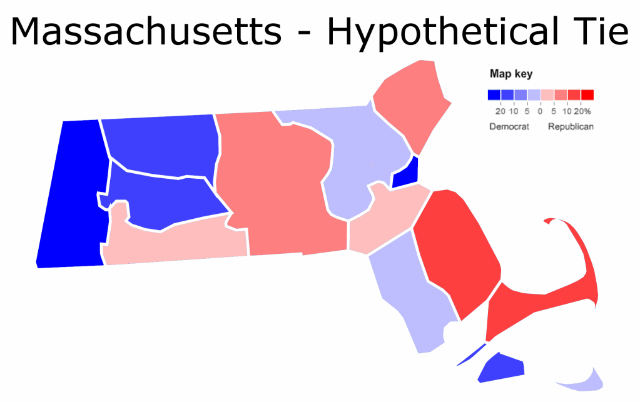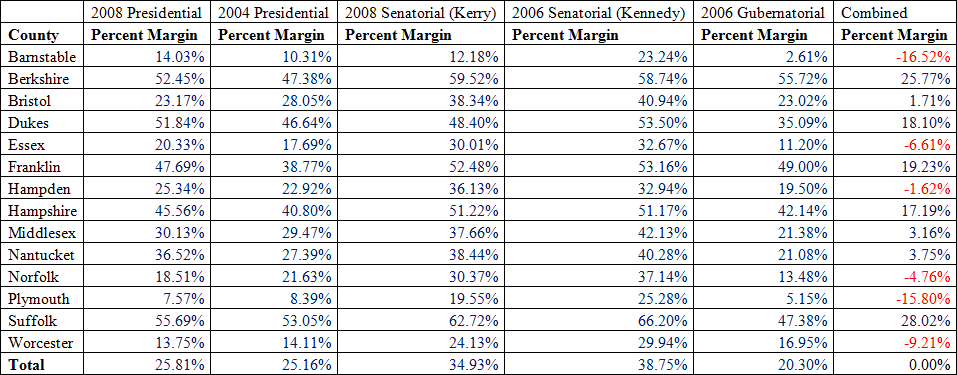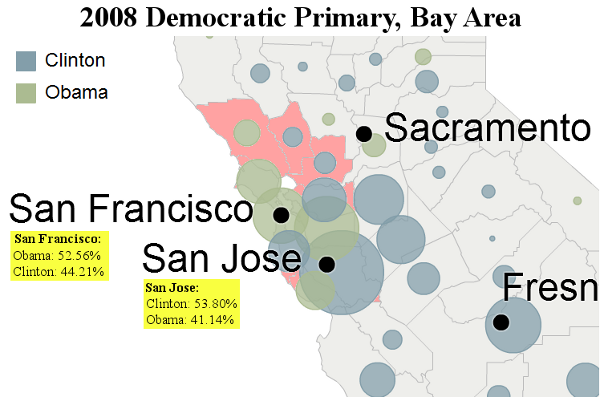Crossposted at Daily Kos
With the 2010 Census just a year away and the next round of nationwide redistricting two or three years away, I’ve decided to start looking at the redistricting situations in different states and begin some conversation about what kinds of changes we can expect to see. These diaries will be sporadic, and the data is always subject to change (for now, county population estimates are from 2007; 2008 numbers will be out soon, meaning my number-crunching will need constant adjusting)…but for we super-geeks, merely the discussion of redistricting and speculation on its effects will be sufficiently entertaining.
My “state focus” redistricting diaries will cover two states, usually one large and one a bit smaller.
Today, I was feeling the vibes of 2004, so we’ll delve into Massachusetts and Texas. Below the fold…
Massachusetts
The redistricting process in Massachusetts is expected to be run by the Democrats in 2011-2012, and even if Gov. Deval Patrick manages to lose to a Republican in 2010, it won’t make much difference for the sake of district maps; all ten congressional incumbents are left-of-center Democrats.
Unfortunately, Massachusetts is likely to lose one seat due to its lagging population growth. You can see the current Mass. congressional map (and it’s quite a mess; the late Bay Stater Elbridge Gerry himself would be proud) here.
So I tried to think like a Democratic state legislator forced to eliminate one of his/her own from Congress. Seeing that population growth was weakest in western Massachusetts, and that Rep. John Olver (D-Amherst) will be 76 at the 2012 election, it seemed logical to combine western Mass’s two districts and force Olver against his then-63-year-old colleague, Richard Neal of Springfield. Most think Olver would retire if pitted against Neal. The other eight seats mostly fell into place, though I dramatically redrew some of them for cleaner, more compact district lines. This was tough because four Congresspeople call Middlesex County home, yet I wanted to avoid splitting counties too many ways. It is doubtful that the legislature will be as averse to messy lines as I was, but this is a rough approximation of what I see coming out of the next round of redistricting (and yes, I think all nine seats should be comfortably Democratic):

District 1 – Olver vs. Neal
District 2 – Jim McGovern (D-Worcester) — picks up the remainder of Hampden County not covered by District 1 but anchored in Worcester County.
District 3 – Barney Frank (D-Newton) — now entirely within Middlesex County.
District 4 – Niki Tsongas (D-Lowell) — dominated by Middlesex, picks up the remainder of Worcester.
District 5 – John Tierney (D-Salem) — now entirely within Essex County, ye olde witch-hunters.
District 6 – Ed Markey (D-Malden) — dominated by Norfolk County, nabs the small remainder of Essex and enough of Middlesex to retain Markey’s home base.
District 7 – Mike Capuano (D-Somerville) — why can’t he just move to Boston? This district grabs 96% of Suffolk County, but had to eat into a tiny section of Middlesex to keep his home intact.
District 8 – Stephen Lynch (D-South Boston) — this one changes significantly: it retains his base in South Boston but is now dominated by Bristol County, theoretically rendering him vulnerable to a primary challenge (not my intent by any means, but the bizarre lines in Middlesex, Suffolk, and Norfolk Counties simply had to end).
District 9 – Bill Delahunt (D-Quincy) — still the Cape Cod/Nantucket district, preserving his home in Norfolk but dominated by Plymouth and Barnstable Counties.
In the end, Massachusetts wasn’t too hard. Certainly not compared to Texas, a state of 32 seats that is expected to gain another four!
Texas
Barring a huge slowdown in migration during 2009 and before the Census on April 1, 2010 (and such a slowdown is possible), Texas should gain four seats for a whopping total of 36 districts. The Republicans currently hold the state government trifecta in the Lone Star State, but only with a fragile 76-74 lead in the state House. Democrats are bullish about winning the House in 2010.
The opportunity to prevent a wrenching repeat of the 2003 DeLaymander in Texas is an exciting one for political junkies, but if my map-making experiment (again, using 2007 estimates, so take with salt) was at all accurate, Republicans are nearly maxed-out on seats in Texas as it is. I attempted in this venture to put on my thinking cap, imagine I was a Republican state legislator, and work to protect all GOP incumbents, weaken Rep. Chet Edwards (D-Waco), and maximize GOP advantages in the four new seats…but because of where the four new seats ended up being located in my simulation, I can’t really imagine Republicans winning more than two of them. Of course, their map artistes are surely far superior in skill to me and my low-tech method, but the point stands: once all 32 incumbents were done, I found significant leftover population in urban Dallas-Fort Worth and Houston, in areas I would expect to tilt Democratic given voting trends in Harris and Dallas Counties.
The other two seats were odd rural-urban mixes that meander and should lean Republican (especially the one stretching down Central Texas from Tarrant County). Here’s the map:

Texas is so large, and its urban seats so small in area, that you can’t even see some of the 36 districts, so here are the details on each one:
District 1 – Louie Gohmert (R-Tyler) — stays safely GOP, merely contracts in area.
District 2 – Ted Poe (R-Humble) — ditto
District 3 – Sam Johnson (R-Plano) — I chose to keep this entirely within Collin County for purposes of compactness.
District 4 – Ralph Hall (R-Rockwall) — remains an odd mix of rural northeast Texas and the far outskirts of the Metroplex.
District 5 – Jeb Hensarling (R-Dallas) — snatches exurbs and small towns in East Texas, but Dallas County is still the largest population source.
District 6 – Joe Barton (R-Ennis) — looks rural on a map but is in fact dominated by Tarrant and Ellis Counties.
District 7 – John Culberson (R-Houston) — entirely within Harris County
District 8 – Kevin Brady (R-The Woodlands) — grabs 92% of Montgomery County and conservative marshy areas north of Houston.
District 9 – Al Green (D-Houston) — dominated by Houston but catches diverse parts of Fort Bend County to remain a Voting Rights Act African-American opportunity seat.
District 10 – Mike McCaul (R-Austin) — still the Austin-to-Houston seat, but weighted more toward Austin.
District 11 – Mike Conaway (R-Midland) — with 35 counties by my count, this is one rural district if ever I’ve seen one.
District 12 – Kay Granger (R-Fort Worth) — dominated by Tarrant, but kept safely GOP because of Parker and Wise Counties.
District 13 – Mac Thornberry (R-Clarendon) — no, actually, this is one rural district if ever I’ve seen one, with 44 counties wholly or partially included.
District 14 – Ron Paul (R-Surfside) — dominated by Brazoria and Galveston Counties, contracting a bit in area due to population growth.
District 15 – Rubén Hinojosa (D-Mercedes) — might be a tad whiter due to shedding some of Hidalgo County and picking up conservative areas up north, but still heavily Hispanic and Democratic.
District 16 – Silvestre Reyes (D-El Paso) — still contained in El Paso County.
District 17 – Chet Edwards (D-Waco) — I tried to think like a Republican and mess with him a bit by edging the district a bit further southeast and even into Montgomery County, but there’s only so much more that can be done to hurt this Dem survivor.
District 18 – Sheila Jackson Lee (D-Houston) — smaller in area, but should still be a VRA “African-American opportunity seat”.
District 19 – Randy Neugebauer (R-Lubbock) — Republicans might like to make him, Thornberry, and Conaway a bit less overwhelmingly safe to help the party elsewhere, but unfortunately for the GOP, its votes are concentrated thickly in West Texas.
District 20 – Charlie Gonzalez (D-San Antonio) — still heavily Hispanic, still entirely within Bexar County.
District 21 – Lamar Smith (R-San Antonio) — I removed Travis County to 1) make him even safer, 2) allow him to concentrate his base in Bexar County, and 3) keep GOP Hill Country voters together.
District 22 – Pete Olson (R-Sugar Land) — anchored in Fort Bend but snaking into Harris and Wharton; probably safer for Olson than before but trending the wrong way long-term for his party.
District 23 – Ciro Rodriguez (D-San Antonio) — the Big Bend district is still dominated by south San Antonio and is probably a bit more heavily Hispanic.
District 24 – Kenny Marchant (R-Coppell) — links northeast Tarrant with northwest Dallas Counties to preserve suburban GOP votes.
District 25 – Lloyd Doggett (D-Austin) — I think the Republicans will finally put him entirely in Travis County to pack Democratic votes and keep fast-growing Central Texas counties open for the taking. They’ve certainly given up on defeating him.
District 26 – Mike Burgess (R-Lewisville) — all of Denton County and a small slice of Tarrant.
District 27 – Solomon Ortiz (D-Corpus Christi) — really doesn’t change much; heavily Hispanic and Democratic-leaning.
District 28 – Henry Cuellar (D-Laredo) — growth is so strong in Hidalgo County that this district sheds its northern reaches and becomes possibly the state’s most Hispanic seat. 90% of Cuellar’s Webb County base is preserved but he could become more vulnerable to a McAllen-area primary challenge.
District 29 – Gene Green (D-Houston) — still a tiny sliver of Harris; I assume it will stay majority-Hispanic, but that mantle could be taken up by the new 35th…I’m not familiar enough with Houston geography.
District 30 – Eddie Bernice Johnson (D-Dallas) — concentrates black neighborhoods of Dallas.
District 31 – John Carter (R-Round Rock) — growth in Williamson County has been stupendous enough that this district is becoming surprisingly small in area.
District 32 – Pete Sessions (R-Dallas) — desperately attempts to grab Republicans in north Dallas.
And now, the four new seats as I found them:
District 33 – Dallas & Tarrant Counties — this lilliputian snake of land vaguely recalls Martin Frost’s (D-Arlington) former stomping grounds, a diverse urban-suburban Metroplex mélange presumably leaning Democratic. In fact, I’m fairly sure of it electing a Democrat, as Republicans have milked every seat they possibly can out of the Dallas area.
District 34 – remainders of Tarrant County, stretches all the way to Guadalupe County near San Antonio — this is an ugly district, with a barely-visible serpentine line down Williamson and Travis Counties. It is meant to find all the Republicans not already accounted for in the 12th, 17th, 21st, or 31st, but I would certainly hope the legislature doesn’t try to draw something so incoherent.
District 35 – Harris County — unlike the masterful DeLay-led cracking of Democratic votes in Dallas-Fort Worth, Houston already has three Democratic Reps., but all in VRA opportunity seats. Is it time for a “limousine liberal” seat in Houston, or is there room for another John Culberson-like Republican?
District 36 – arches from north of Laredo through San Antonio to the coast — less bizarre than the 34th, but still an oddity, this seat’s population base is Bexar County but should elect a Republican despite its decent Hispanic population. The odd nature of this district was necessitated by VRA Hispanic seats like the 23rd and 28th dropping their “whiter” counties. If Henry Bonilla (R-San Antonio) ever wanted to stage a comeback, my 36th would be a great shot for him.
I’m not exactly pleased with some odd boundaries in this map, especially the downright psychedelic 34th District. The explosive growth in three areas — the Metroplex, Houston, and Central Texas around Austin — meant some odd leftovers when all incumbents were solidified. But the real point here is that, even if Republicans still run the process in Texas next round, their room for growth is limited. My plan might allow them as great as a 24-12 majority should they defeat Chet Edwards, but 23-13 is more likely. Perhaps an experienced Friend of Elbridge (and by that I mean a professional gerrymander-er) could craft something more advantageous, but as long as Democratic strength grows in the metro areas, protecting suburban GOP incumbents like Kenny Marchant, Kay Granger, and Pete Olson will be the utmost priority. I really think redistricting could be a wash in the Lone Star State, whether Republicans control the House or not.
The next diary will map Michigan and Nevada; after that, we’ll get Iowa and my greatest masterpiece to date, Ohio.














